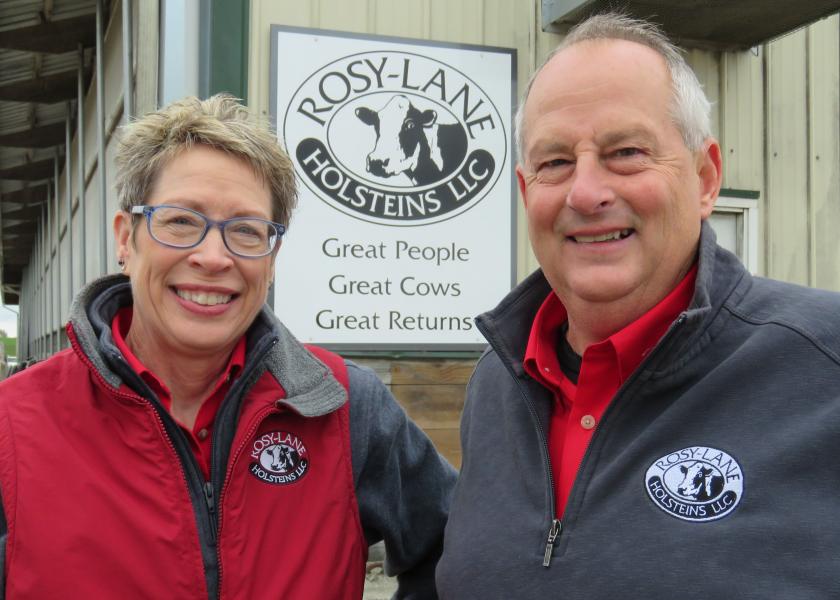They Haven't Used a Lactation Tube in 68 Months--and Counting

Jordan Matthews and his milking crew at Rosy-Lane Holsteinshave not used a lactation tube of antibiotics in the milking herd to treat mastitis for 68 months and counting.
That’s quite a feat, considering Rosy-Lane milks 950 cows 3X with an average production of 99 lb. of fat- and protein-corrected milk per cow per day. Total herd size is 1,100. Rosy-Lane is owned and managed by Matthews, Lloyd and Daphne Holterman and Tim Strobel, and is located near Watertown, Wis., which is just east of Madison.

Though they don’t use lactating tubes, that doesn’t mean Rosy-Lane doesn’t treat cows for mastitis. They’re big believers in supportive therapy, which includes fluids, electrolytes and yeast in the form of IVs with hypertonic saline and drenching cows.
“Fluids, fluids, fluids are a beautiful thing,” Matthews says. Most cows fighting off a bout of environmental mastitis will respond to supportive therapy if it is performed quickly after an infection is first detected, he says.
“If the cow doesn’t cure, we’re not married to her, and she goes on the truck,” he says. “We’ll cull after three days if there is no response.”
That’s not as drastic as it seems because the farm usually treats just one case of mastitis per month. And about 75% of the cows treated this way recover. Over the past year, Rosy-Lane has culled only three animals that didn’t respond to the mastitis treatment protocol.
MANAGEMENT PHILOSOPHY
The key is through on-farm milk culturing. Matthews has learned virtually every case of clinical mastitis that occurs in the herd comes from Klebsiella and E. coli. Neither organism typically responds well to antibiotic treatment.
Beyond that, the no-treat approach is really the end result of a management philosophy that emphasizes strong immunity and clean, comfortable cows that calve in a low-stress environment.

In 2012, the herd had a 5% death loss, 6% clinical mastitis rate and a somatic cell count of 215,000 cells/mL. “We were pretty average, and we had plenty of room for improvement,” Matthews says.
One of the first things to change was their calving protocol, thinking that if cows calve without assistance, there is less chance of stress, retained placentas and uterine infections. And if heifers and cows calve in better, they would perform better in the parlor.
“We changed our calving procedures to just-in-time calving,” Matthews says. An employee walks the late dry pen every 15 minutes, watching for cows to start the calving process.
The employee waits to move a cow to the calving pen until he or she sees the calf’s feet. If the presentation is correct, the cow or the calf isn’t touched for eight hours and the natural process of calving is left to proceed. “We’d rather mess up that one out of 100 calvings that doesn’t go well rather than mess up the 99 that will occur naturally on their own,” Matthews says. But he adds, “We do put cameras on our calving pens so we can watch progress.”
SIGNIFICANT IMPROVEMENT

The results have been impressive. In 2012, the herd was culling 8% of fresh animals before 60 days in milk. Now, that number is 2.4%. Retained placentas, which had been running at 16% in 2012, have now dropped to 1.5%.
Both pre- and post-fresh pens are stocked at 85%. The healthiest cows are moved into the lactation groups 15 to 21 days after calving. Matthews likes to see fresh heifers reach 75 lb. of milk per day before they are moved; second-lactation and older cows at 100 lb.
Cow comfort is also critical to alleviating stress. Alleys in the barns are scraped three times each day. And fresh, washed sand is added to the freestalls twice a week.
All fresh cows and early lactation cows, up to 150 days in milk, are housed in a 500-cow, eight-row cross-ventilated barn. When first built, the barn had cooling pads on the inlet side of the building, but after a few years, the pads became more hassle than they were worth.
“When we removed the pads, we saw an increase in air speed across the barn and a decrease in air humidity,” says Matthews. “That made a big difference in sand bedding dryness and mastitis rates.”
MILKING ROUTINE
The herd is milked in a double-12 parallel parlor, equipped with an Afi-Milk system that detects milk conductivity. Spikes in conductivity alert milkers a cow might have a case of mastitis. If confirmed, the three-day fluid therapy protocol is started.
Extra lighting was added directly under the splash pan a few years ago.
“You can’t do a good teat cleaning job if you can’t see. The extra light allows milkers to see the teat ends much better,” Matthews says.

Milkers wear nitrile gloves to prevent spreading any mastitis organism cow to cow. A full prep routine is used with microfiber towels used for drying teats. Over time, SCC levels have dropped 25,000 cells/mL and now routinely average below 200,000, he says.
Matthews and his crew still routinely use antibiotics at dry off to cure any existing, subclinical infections that are present.
Another benefit to the no-antibiotic approach for clinical mastitis is Rosy-Lane does not need a hospital group for treated cows. Such a group can slow parlor efficiency as the group is milked separately, milk diverted and lines washed. “When we were treating cows for mastitis, we were only getting about 800 cows through the parlor each day,” Matthews says.
“Last week, we had 950 cows go through the parlor. That’s a pretty big savings in efficiency, and one we’re willing to sacrifice for three or four cows a year who don’t respond to fluid therapy,” he says. “Those cows that get culled likely have low immunity, and we don’t want that type of cattle in our herd anyway.”
For more on milk quality, read:







